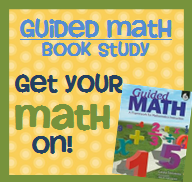Guided Math Chapter 5
June 29, 2012

Welcome
to Guided Math Chapter 5: Using Guided Math with Small Groups
My take
away from this chapter was that small group math instruction is the perfect
place to provide all students with access to core instruction. This means you
have to differentiate the what (curriculum) not change it. Small
group math gives you the time to do that--just like you would in Guided
Reading.
This
got me thinking about how flexible, needs based grouping affect student
learning. I know with guided reading, students move all the time. Why could the
same not happen with math. My building has been playing with adding small math
groups to the math block. You'll see the schedule below. But I do know that
when you group students by math need and provide them time/practice to access
core they do get it. They get it and it shows everywhere when they do.
Why Small Group Math?
The Kids
Learn at their ability level
Experience Success
Grow in Self esteem
Enjoy math
Gain new understandings
Are allowed frequent movement
Participate in activities of appropriate length
The Teacher
Knows exactly where each kid stands
Has time to work with individuals in small groups
Has less frustration
Uses time more efficiently
Small
Group Math Instruction allows you to address the needs of your class, in a way
that targets students’ strength and needs, tailor instruction to provide the
specific instruction that best challenges all learners. Students receive the
support they need to expand their understanding and improve their math
understanding. Fountas and Pinnell say this about small group
instruction, "in the comfort and safety of a small group, students learn
how to work with others, how to attend to shared information, and how to ask
questions or ask for help." For students who struggle with math learning
these things is key for their success. Small group math allows teachers to
challenge all learners by providing instruction at varied levels of difficulty
and with scaffolding based on needs. Small group math instruction lends
itself to differentiation. It fits perfectly into
the Gradual Release Strategy that is used in Guided Reading.
One example of how students could be grouped is from low to high.
The low group starts with the
teacher at the Work With Teacher Station. This group is met with first, so that
they are taught the lesson before being asked to work independently or play a
game related to the concept I am teaching. I use a small dry erase
board or the interactive whiteboard for my instruction, and the students sit in
front of me on the carpet. They bring their math journal with them
because I often have them work on the math journal pages with me
during the lesson. This would be the time to provide remedial instruction for
students as well.
The medium group starts at the Math Games
Station. They are often playing the game that is part of that
day's Math lesson, but they may also be playing a game
that they have played in the past that corresponds to the concepts in the
unit. Sometimes students are also doing projects at this
center, especially during the fraction and geometry units.
The high group starts at the Independent
Practice Station. I have them start at this station because they are
often able to do the math journal pages without much instruction. Each
day, they are asked to complete the journal pages that correspond to the
lesson I will be teaching. The high group is also given a math packet
created by our "Gifted and Talented" teacher because they often
finish the math journal pages before it is time to rotate to the next station.
Depending on the need of the students, like in guided reading,
you may not meet with all three groups every day. But you need to meet with
every group at least once a week. You may meet with your lowest group four of
five days, the next lowest group three of five days, the middle group two of
five days and your high group only once.
Daily
Schedule for Math Block
I have one hour and 30 minutes scheduled for math each day
(90 minutes). Below is how my building uses that time.
Number Talks: (8–10
minutes) As a building we use Number Talks: Helping Children Build Mental
Math and Computation Strategies, Grades K–5 By: Sherry Parrish
Lesson Introduction & Directions: 15 minutes) During this time, I briefly introduce the
concept I will be teaching for the day, announce any materials they will
need to do their daily work (rulers, protractors, etc.), and explain the
game that students will be playing at the Games Station (if necessary).
Rotation #1: (20 minutes)
Rotation #2: (20
minutes)
Rotation #3: (20
minutes)
Closing: (5
minutes) At the end of math, I call the class back together quickly to
reinforce the day's concept. If there is time, we will correct the
daily math journal page as a class.
I have
included two videos examples of what guided math can look like in classrooms.
I have created a Small Group Lesson Plan Template to help in your planning for Small Group Math.
A couple of questions to get the juices flowing:
1) Do you use Guided Reading, how can you use that idea to work in small group math to accommodate all learners? What would be easy? More difficult to adapt?
2) What data do you already have that would help you create those groups?
A couple of questions to get the juices flowing:
1) Do you use Guided Reading, how can you use that idea to work in small group math to accommodate all learners? What would be easy? More difficult to adapt?
2) What data do you already have that would help you create those groups?

Labels:freebie,Gradually Release,math,small group,Video
Subscribe to:
Post Comments
(Atom)

About Me
Welcome to my all thing special education blog. I empower busy elementary special education teachers to use best practice strategies to achieve a data and evidence driven classroom community by sharing easy to use, engaging, unique approaches to small group reading and math. Thanks for Hopping By.
Resource Library
Thank you! You have successfully subscribed to our newsletter.
Search This Blog
Labels
21st Century
Autism
Bloom's Taxonomy
DIBELS
ELL strategies
Formative Assessment
Fountas and Pinnell
Guided Reading
IEP
Just Words
Progress monitoring
RTI
Reading Comprehension
Wilson Reading System
apps
back to school
beginning readers
best practices
books to read
classroom
common core
comprehension
data
differentiation
fluency
freebie
intervention
lesson plan
math
parents
phonics
reading
small group
special education
teaching
technology
vocabulary
writing











This is an excellent post. I am your newest follower. I popped over from TBA Friday Freebies. I am going to try to do Guided Science as I am teaching 6-8th grade Science next year. The videos were great too.
ReplyDeletePamela Fulk
First Class Teacher
I love your idea of obtaining work from the Gifted teacher! I will be collaborating with our G/T teacher next year!
ReplyDeletePatti
On The Road To Success
I am your newest follower! Thanks for the great ideas!
ReplyDeleteGreg
Smedley's Smorgasboard of Kindergarten
Can you share where you found these videos? It sounds like there might be a few more clips out there that I'd like to check out. I just finished my post on Chapter 5. Head on over to check it out :)
ReplyDeleteStorie
Stories by Storie
Thanks for stopping by. I hope you find something you can use with your students. The videos are from You Tube.
ReplyDeleteAlison
I use Number Talks, too! And I frame my math block (on the days we do small group)exactly the way you have mapped out. I do group my kiddos a bit differently, though...I found that grouping all the lower kiddos in one group just wasn't successful...too needy & not any peer support.
ReplyDeleteThanks for the freebie too! Awesome!
Primary Inspired
Thanks for the great post! I just got my book today and I'm so excited to get started planning. Our school just went to a 90 min math, your schedule is very helpful as I switch to that. Thanks again!
ReplyDeleteThanks for hosting the chapter and replying to my comment. I'll head back over to You Tube and do a search for the videos. I'm also passing on the One Lovely Blog award to you :) There's more info about it on my blog.
ReplyDeleteStorie
Stories by Storie
I love the visuals you gave. They can really be helpful to wrap your head around the concept. Thank you for those. I also have a schedule quiet similar to yours! I feel like it has made such a difference. I definitely want to look into your mention of number talks. Can you tell me more about how a number talk by look/go? Thanks! :)
ReplyDeleteAmanda
Reaching for the TOP!
I used to be the Gifted teacher in my bldg and I loved collaborating with other teachers. My position was dissolved and now we have Reg and Accelerated classes. I'll be teaching Acc 5th gr next year. Highly recommend to use your staff resources to assist in student learning for each small group level i.e. Gifted Teacher, LD, ELL, etc.
ReplyDeleteMy math class is only 60 min and we are locked to that time. I'm still trying to figure out how to budget my minutes.
I love your post. Come check out my thoughts on it:
ReplyDeletehttp://secondgradesweets.blogspot.com/2012/07/made-it-monday-winner-chapter-5-guided.html
I agree Denise I'm still trying to figure out how to budget my time.
Brittany
Sweet Seconds
In the past, we have only 60 minutes for math. Many teachers only did number talks a couple of days a week or found a different time to do them (like before/after lunch) or limited the number of groups so they could meet with everyone at least twice over the week. In some cases, it was the first thing to go out the window if it needed to. This chapter reminded me a lot of setting up guiding reading group-not too may and commit.
ReplyDeleteAlison